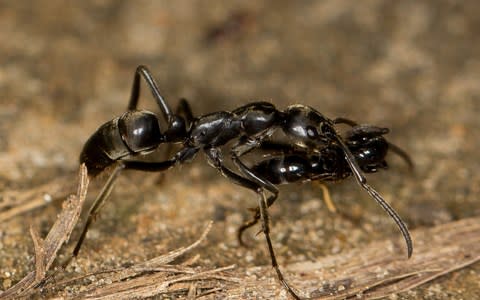Ants armies use human-style battlefield medicine and treat each others' open wounds - new study

Ant armies employ a system of battlefield evacuation and emergency medicine similar to that used by humans, researchers have discovered.
Groundbreaking new observations of mass raids on termite colonies revealed the open wounds of injured ants are swiftly tended to by comrades in a bid to save them for future attacks.
Described in the journal Proceedings of the Royal Society B, the behaviour is the first such example discovered anywhere in the animal kingdom.
Entomologists studied more than 200 raids carried out by 16 Matabele ant colonies in Cote d’Ivoire as well as in laboratories.
They witnessed savage battles as 600-strong ant armies carried out coordinated raids on termite settlements in order to drag the insects away for food.

Many were injured in the encounters, with limbs ripped off, yet once carried home the open wounds were intensively treated by other ants with saliva that may have antimicrobial properties.
Scientists at Wurzburg University calculate it reduced the injured ant’s chances of dying from 80 to 10 per cent.
Last year the same team discovered that injured ants are able to send out distress signals in the form of pheremones indicating they need evacuation and treatment.
But the new research reveals that only the ants capable of rehabilitation and future combat were saved.
Those with one or two legs ripped off were routinely carried home, sometimes up to 50 metres, and often later returned to the fray - approximately one third of frontline, or “minor”, ants are amputees.
By contrast, those who had lost five or six limbs were rarely evacuated.

However, this was not due to the callousness of their comrades, but because the badly injured made it impossible to be carried.
The study found that the slightly injured ants were able to tuck in their remaining legs and keep still, whereas those who had lost five or six legs thrashed around wildly.
"They simply don't cooperate with the helpers and are left behind as a result," said Dr Erik Frank, who led the research.
He told The Daily Telegraph that it is particularly important for Matabele ants to treat their injured because they live in relatively small colonies - roughly 1,000 to 1,500 individuals - and at ten to 15 ants per day have quite a low birthrate, meaning that individual ants are valuable.
But he said European species of ant, such as the slave-making ant, may also treat each others’ wounds.

“Our observations are the first, to our knowledge, to show this type of treatment to be directed towards a high-risk infection zone of an individual's open wounds,” said Dr Frank.
"We show organised social wound treatment in insects through a multifaceted help system focused on injured individuals.
“This was not only limited to selective rescuing of lightly injured individuals by carrying them back, thus reducing predation risk, but, moreover, included a differentiated treatment inside the nest."
The research team observed that in injured ants who received treatment, wound clotting usually occurred within 10 minutes.
Those who lost limbs and survived were able to adapt to having fewer legs very quickly, successfully walking again within 24 hours on average.
Although not proven, the Wurzburg University team believe the wound healing properties come from the ants’ metapleural and venom gland, which are known to excrete antimicrobial substances.

